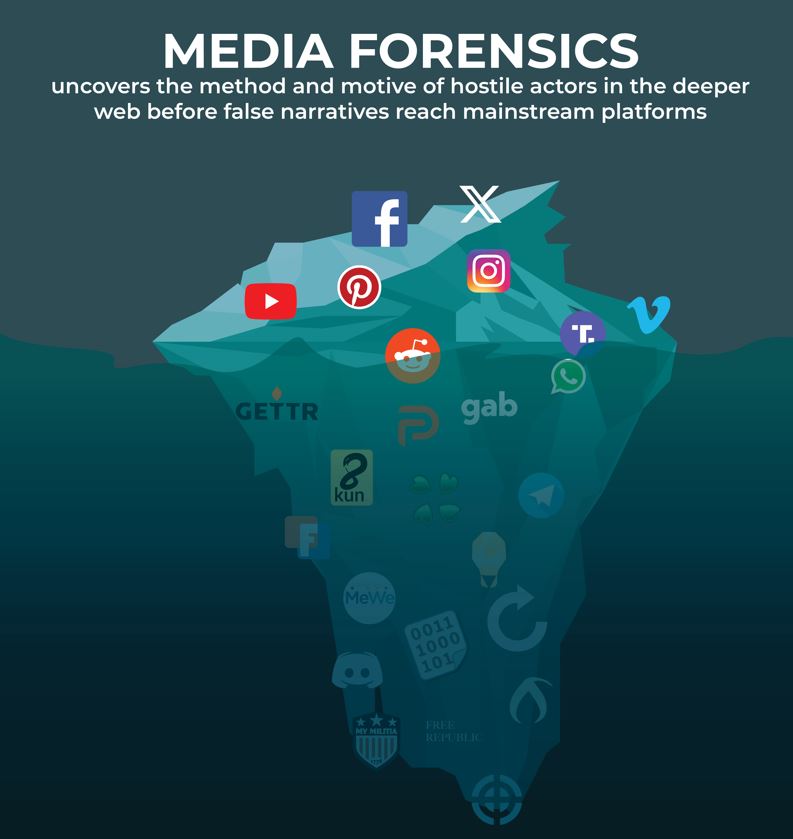-
Media Forensics is guided by three assertions:
Evolving tech & tactics
The current tools and methods used to manage crises and brand reputation are out-matched by today’s evolving technologies and the aggressive tactics used by those who employ them.
Media Forensics
Protecting your most valuable asset — your brand.
Effective public relations has historically been achieved by air-tight key messages, finely trained spokespersons, expert media relations and well-crafted press releases. These key elements are just as vital as ever, but more is required to thrive in today’s chaotic communications environment.
When managing a campaign or addressing a crisis, brands communicate in an unprecedented environment of misinformation, cultural divisions and disruptive technologies. These intersecting challenges have made strategic communications an incredibly complex, stressful and resource-intensive undertaking. Our solution to this challenge is called media forensics.
Media forensics works to:
- uncover the reason a person is sharing mis/disinformation (motive) and how they’re sharing it (method)
- identify how it intersects with cultural flashpoints
- determine how likely that combination is to ignite social algorithms and mainstream media into sharing it widely
- expose synthetic networks, algorithms, bot farms, artificial intelligence, deep fakes and other technologies being used against your brand or organization
- calculate the viral potential of any narrative using measurable indicators
- define the appropriate communications strategy based upon the above forensic investigation techniques
Media forensics also conducts crisis simulation trainings that mimic how crises play out in both social and traditional channels, integrating misinformation, coordinated attacks, bot networks and other common challenges found in today’s media landscape. It also provides campaign readiness services that protect brands during a product or services launch by preparing for potential backlash by antagonists.
Media Forensics is guided by three assertions:
-
Media Forensics is guided by three assertions:
Amplifying cultural flashpoints
By hijacking a brand’s popularity, individuals and/or mobilized groups amplify cultural flashpoints to drive an agenda, make a joke or avenge a grudge.
-
Media Forensics is guided by three assertions:
News & truth
In an attempt to remain financially viable, mainstream news often veers away from public interest and toward individual eyeballs. Consequently, objective truths are increasingly overlooked or distorted, forcing brands to defend against risks both real and imagined.
Media forensics is a contemporary approach for strategic communications that addresses the realities of our current media ecosystem. It combats the proliferation of fake news, misinformation and disruptive technologies and their effectiveness at sowing chaos into culture, using brand awareness as fuel. It asserts that communications today is competing on an uneven playing field where antagonists distort truth to push their own agendas; moreover, it further suggests that to win on this playing field, a different strategy from the past must be engaged.
Our media forensics approach provides solutions for each of these challenges by:
Employing a suite of data-driven tools to go deeper than any traditional listening solution on the market. We understand that negative trends and conversations often originate in the deep web, telegraphing potential challenges if they become mainstream. By being aware of these early disruptive efforts, our clients can prepare for disruption in advance rather than reacting to them only when they are mainstream.
Maintaining an ongoing assessment of cultural flashpoints that can become a concern for any brand. This approach protects both brand and business by maintaining constant surveillance of these issues–including the key players and platforms promoting cultural discord–and how they may become part of the brand narrative.
Understanding the dynamic of algorithms and synthetic content and how it impacts media coverage, Media forensics re-calibrates messaging and content to meet the “individual first” eyeball-grabbing approach that defines much of today’s mainstream news.
